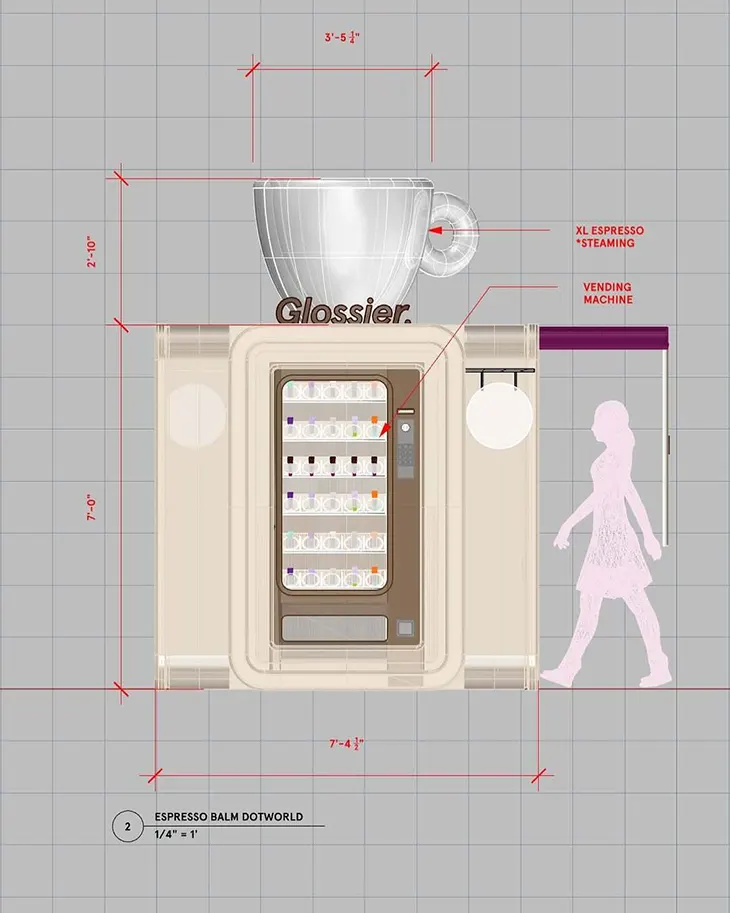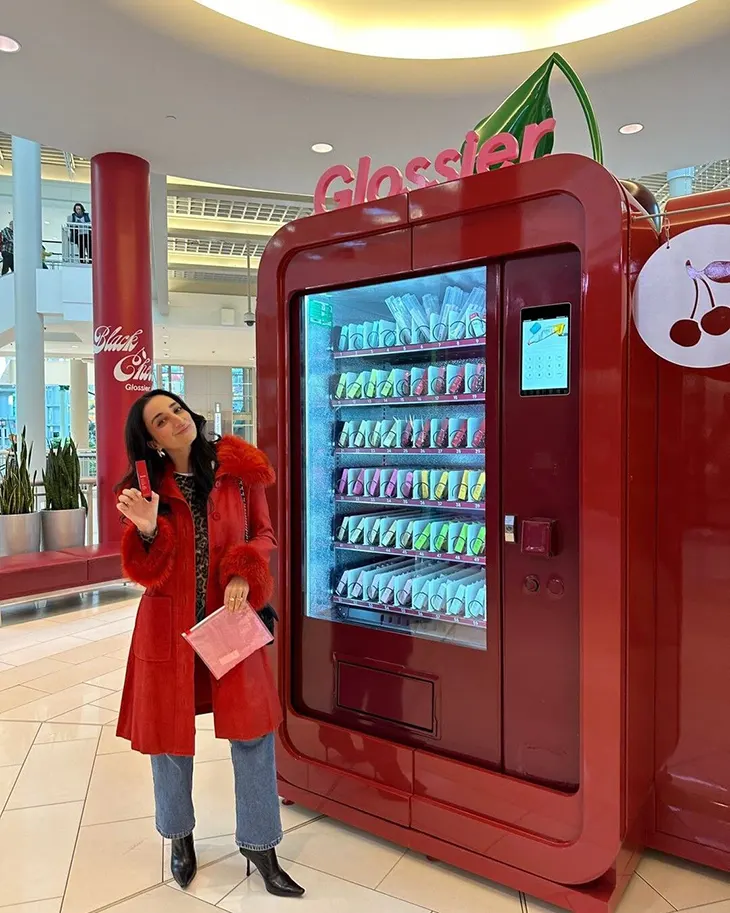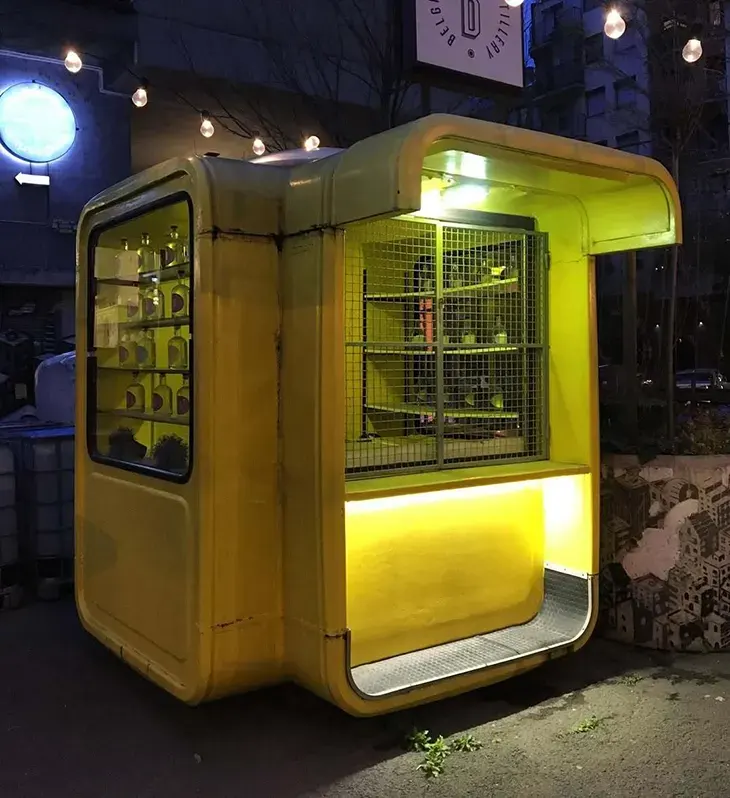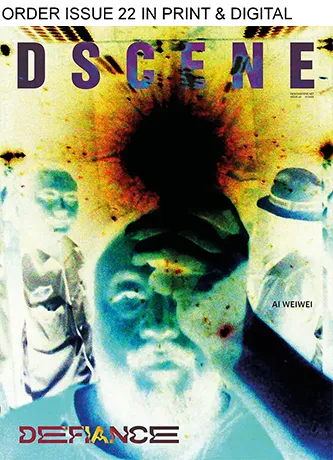
Glossier’s recent wave of pop-up vending machines borrows from a piece of 20th-century industrial design: the K67 kiosk. Designed in 1966 by Slovenian architect Saša J. Mächtig, the K67 was envisioned as a modular, fiberglass structure adaptable to numerous urban uses. From newsstands and food stalls to ticket booths and cafes, the kiosk became a ubiquitous feature across the former Yugoslavia. Its compact footprint, ease of assembly, and distinctive red exterior made it both accessible and instantly recognisable. By referencing the K67’s structure in their pop-up units, Glossier introduces a modular architecture that aligns closely with its mobile, consumer-first marketing strategy.
DESIGN
This design reference goes beyond surface-level inspiration. The core philosophy behind the K67, parallels Glossier’s own approach to experiential marketing. Each activation is site-specific and purpose-built, tailored to a particular campaign or product launch. When Glossier brought its Balm DotWorld installation to Bloomington for the Black Cherry campaign, the vending kiosk appeared in a vivid red, visually consistent with the fruit-themed collection and a direct nod to the original K67 colorway. Later, for the Espresso Balm Dotcom launch in Philadelphia and Houston, the same format underwent a palette shift to a milky beige, echoing the coffee-inspired theme of the product. The shift from red to beige illustrates how Glossier uses the kiosk as a flexible visual device, adapting its appearance to mirror the mood and messaging of each campaign.
Прикажи ову објаву у апликацији Instagram
Where Mächtig’s kiosk system was shaped by the logic of postwar urban planning, designed to fill infrastructural gaps, Glossier repurposes its visual cues to create targeted consumer engagement. The vending kiosks serve as short-term interventions in public space, offering product sampling, personalized merch, photo booths, and limited-edition items. Rather than operating as passive retail outposts, these modular machines function as brand activators, generating foot traffic, social media content, and real-time engagement with Glossier’s consumer base.


The architectural strategy complements Glossier’s broader retail and branding ethos. In permanent stores like its Soho flagship, the brand invests in immersive, aesthetic-led environments that integrate merchandising with experiential architecture. The vending kiosks apply a distilled version of this model on a smaller scale. Designed for quick deployment and high visibility, they allow Glossier to embed its brand in high-traffic urban settings without the overhead of traditional retail. This modularity, drawn directly from the K67’s original principles, enables Glossier to test new markets and build local awareness in a highly flexible format.
Прикажи ову објаву у апликацији Instagram
While the form of the kiosk is immediately eye-catching, it is Glossier’s integration of content, community, and customization that turns the installation into a marketing tool. Free charm stations, selfie-ready design features, and product exclusives are built into the structure, transforming what could be a transactional space into a multi-sensory brand experience. This reflects a broader trend in consumer marketing, where brand activations must operate simultaneously across physical, social, and emotional channels.
From a brand strategy perspective, these mobile units fit neatly into Glossier’s consumer-centric playbook. The brand has consistently positioned itself as a platform for participation rather than passive consumption. This extends from its packaging, designed to be photographed and shared, to its emphasis on user-generated content.

The continued relevance of the K67, decades after its initial production, lies in its architectural agility. Glossier’s adaptation of the format shows how such a legacy design can be recontextualized within a contemporary marketing framework. By translating the kiosk’s original intent into a branded experience, Glossier demonstrates how industrial design can still inform retail innovation.



















